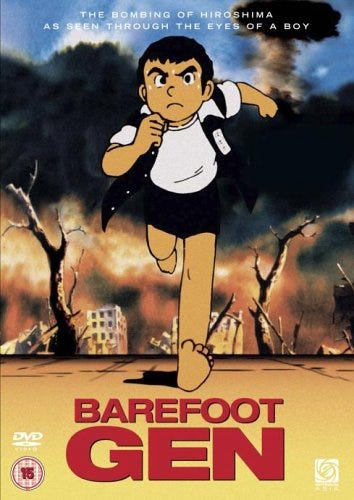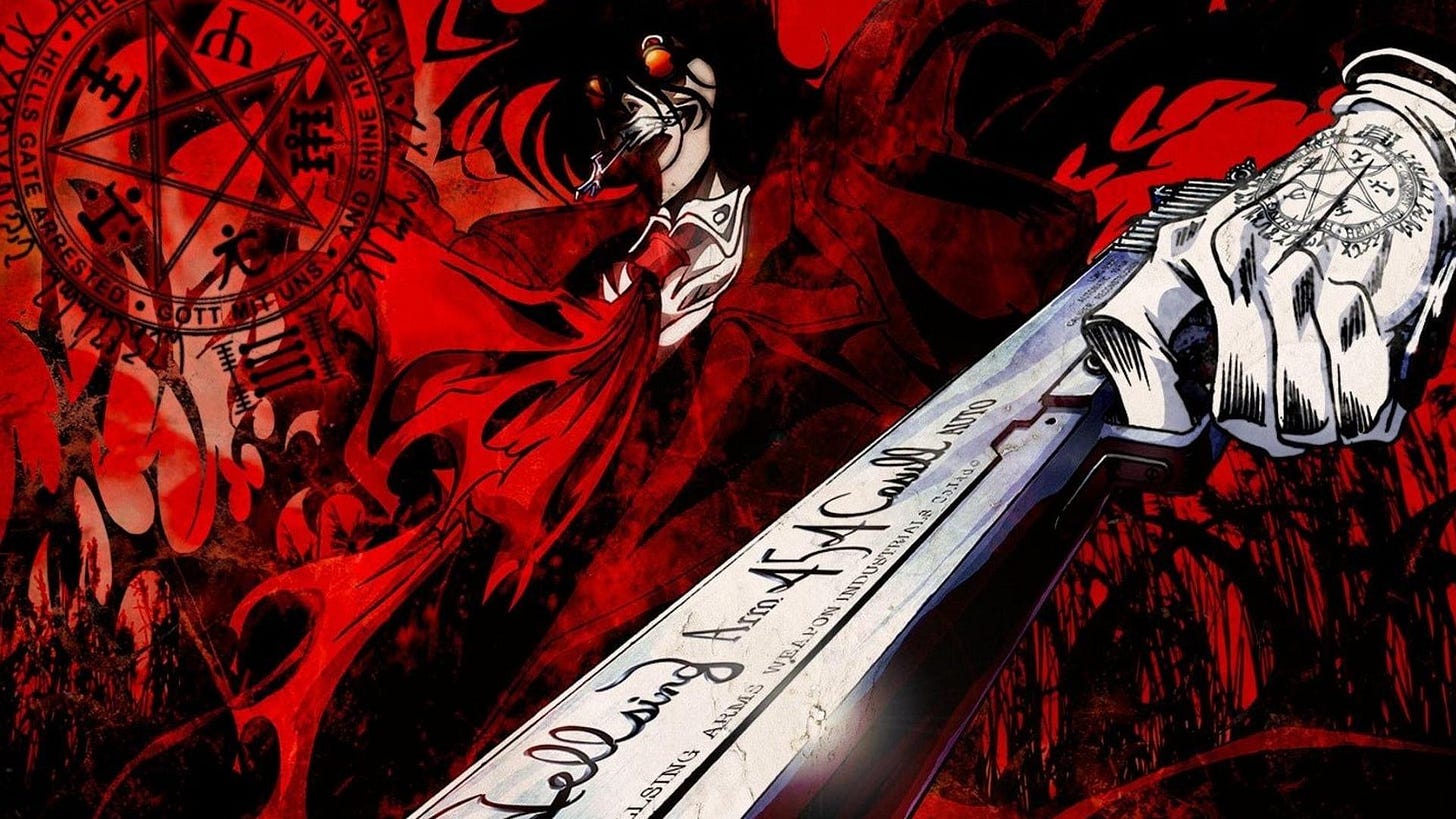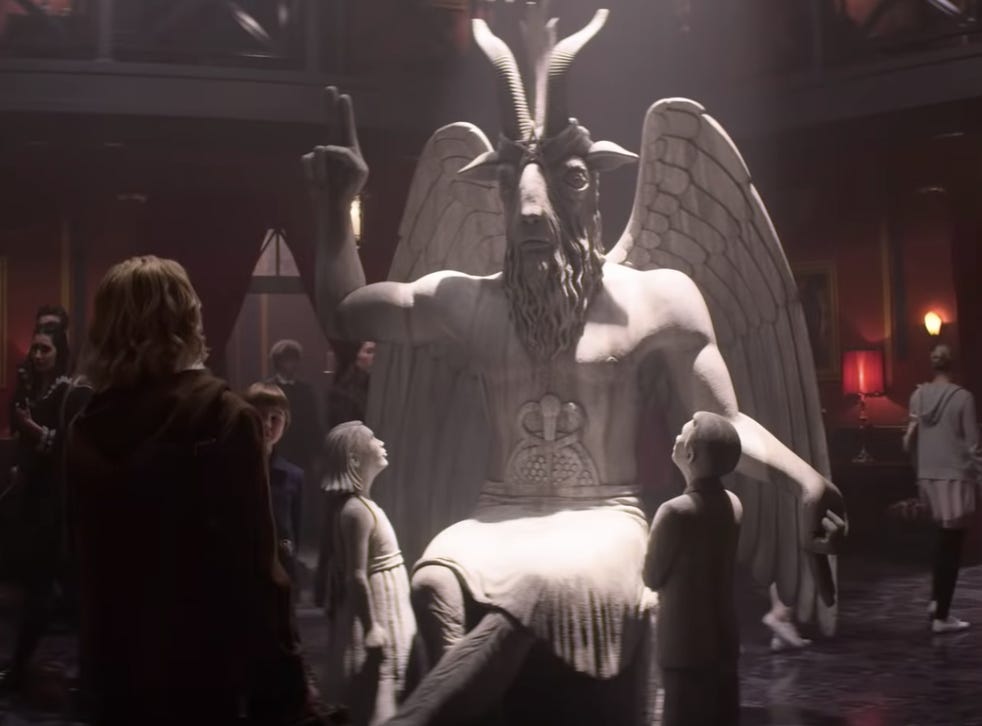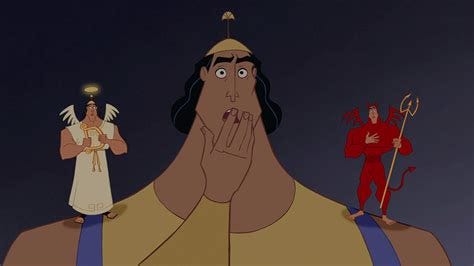Why is Anime So Controversial?
Matt Walsh's accusation of anime as "satanic" is largely a cultural misunderstanding. An argument in favor of the medium--with many caveats, especially for parents of young children.
No, Matt Walsh, anime is not “satanic.” Ok, well, some of it is kind of satanic, but unless you have a Western and Christian perspective, can it really be intentionally “satanic”? Or are the creators of anime simply playing with another culture’s mythology? Anime can be no more satanic than The Last Samurai can be authentically Japanese. Just as Westerners love to romanticize Japanese culture, there are Japanese artists who also love to romanticize Western culture.

I love anime, but not all of it. I also love reading books, but I do not love all books. Anime is a blanket term for Japanese animation. Manga, which are Japanese comics, have a long, rich history going back to the Edo era when printed booklets became affordable and more consumable for a more general audience. Manga boomed in Japan just as comics boomed in the West throughout the 20th century. Many anime are based on their manga counterparts, bringing to life the stories that were popularized in comic form. Anime and manga can provide unique perspectives and glimpses into Japanese culture, and it is essential to have a basic understanding of the native culture and religion before you can accuse them of being “satanic.” Anime and manga have also sparked controversy, especially as parents make the false assumption that “cartoons are for children.”
Culturally, anime and manga hold a different place in society than animation and comics have in the West. In the West, animation is primarily for children or the “young at heart.” In Japan, the audience is much more diverse, with specific anime and manga being more appropriate for some audiences than others. This distinction is crucial for parents to understand as their children become interested in manga and anime.
Rather than American animation, which is ubiquitous with Disney, anime was never considered a medium exclusively for children’s entertainment. There are many that do just that: Doraemon, for example, is a long-running favorite for children about a robot cat from the future. On the other hand, early seasons of Lupin the Third could be compared to the violent, sexist, live-action detective shows in the U.S. that were also popular with men in the 1970’s when it first started airing.

Throughout the 20th century, animation could do things no other art form could dream of attempting without it looking tacky while also being prohibitively expensive. Japanese animators dreamed up detailed sci-fi aircraft and military weaponry like mechs and androids in exquisite detail, as we see in Evangelion. Anime and manga also tackles challenging topics and provides cultural critique, bringing to a mainstream audience historical and cultural events in its unique narrative form. Animated perspectives of World War II, as in Barefoot Gen and Grave of the Fireflies, become all the more horrifying and impactful through their depiction in animated form.

Many studios pride themselves in their storytelling and art. Studio Ghibli has created films so beautiful and powerful with such attention to detail, even the best American animation can’t hold a candle to it. While Hayao Miyazaki focused on the realism of the movements of the human body, Disney focused on cutting as many corners as possible to maximize profit. Miyazaki was creating art, while Disney was creating a product. This alone might motivate viewers young and old to expand their taste for animation beyond the scope of child-focused, profit-driven American animation and into the world of anime.
Matt Walsh, conservative political commentator, does not like anime. In October 2022, he commented:
"I think it's all Satanic. I have no argument for it, I have no argument for why it's Satanic; it just seems that way to me.”
As an anime fan and a Christian, I strongly disagree with Walsh. Rather than disparage him and write him off, let’s wonder why he would think that way, as his comment is reflective of many concerned parents. There are shocking themes in anime and manga that most Westerners would never expect from cute cartoon characters. Specific anime are more appropriate for children than others, and much of the anime that has been popularized in the U.S. is targeted at teens and adults.
Considering Walsh’s political perspective, I am not surprised by his assessment. He is a Daily Wire contributor and is well-known for the documentary “What is a Woman?” Walsh is concerned with the gender ideology agenda specifically, and in the West, there is a lot of crossover in the circles of anime fans and LGBTQ+ culture. It is not that surprising, as many anime do play with gender roles and explore coming-of-age themes around one’s sexuality. Still, it is fascinating how this crossover happens, as Japan is far more culturally conservative than the U.S.: same-sex marriages remain banned in the country, and there is a legal obligation to blur or pixelate the genitalia in pornography, real or animated. Historically rigid gender roles invite social critique, and anime and manga often play with cultural taboos. The way these are perceived in the West unfold in fascinating and occasionally problematic ways: there are particular corners of Reddit where MTF trans-identifying folks are obsessed with the idea not of becoming a real girl but a cartoon version of a Japanese schoolgirl. This fetishization is racist, sexist, and oddly normalized amongst a population where racism and sexism is typically vehemently railed against. Cultural appropriation is acceptable in this community when it is a part of the performance of being female. These intersectional mental gymnastics are largely an English-speaking Western phenomenon, however, and they only pertain to a small percentage of anime fans. The danger of radicalization into gender ideology, what Walsh might deem “satanic,” is far more prevalent on English-speaking social media echo chambers than it is in simply watching another culture’s engaging cartoons.

Just like with any media your child consumes, you should screen the content they are interested in. There are some incredibly dark anime that are for mature audiences only, some of which certainly borrow satanic themes (Hellsing comes to mind). Some anime absolutely push the boundaries of art and pornography (be it sexual pornography or “gore porn”). I am still haunted by Elfen Leid and its gory, Lolita Complex, transgressive themes that push every boundary and I would not wish it on my worst enemy. I am similarly haunted by the “gore porn” live-action European film Hostel, with its gratuitous depictions of torture.

Popularity is no indicator of appropriateness; some of the more popular anime are known for their violence, gratuitous gore and shocking themes. The name alone should hint that Chainsaw Man is clearly for mature audiences only, a splatter-horror series complete with devils and demons. Attack on Titan would be enjoyed by a similar audience as The Walking Dead, and it is just as brutal in its depiction of an otherworldly, human-like, apocalypse-inducing enemy combined with the worst aspects of human nature amongst its survivors. The target audience for these anime are young adults, not children.
On the other end of the anime spectrum you can find Chi’s Sweet Home, an adorable series about a kitten and his loving home. My two-year-old daughter loves Chi almost as much as she loves Ponyo, a fantastic G-rated story about a magical fish-spirit that becomes a real girl. Let’s compare it to The Little Mermaid, where the heroine is an underdressed dimwit who loses her voice to a sea witch in exchange for legs. Ponyo becomes a girl with her own magic, while Ariel is cursed by a literal witch—if one of these stories must be “satanic,” it is certainly The Little Mermaid.
Netflix’s new live-action series targeted at young adults, The Chilling Adventures of Sabrina, is quite literally satanic in a way that anime could never be due to its cultural roots. Satan and satanic imagery casually abound in the series, a theme that Western audiences are familiar with from living and interacting in a culture with largely Christian and European roots. With just 1% of the population of Japan identifying as Christian, Shinto and Buddhism have been the predominant religious traditions for centuries. Thus, depictions or themes that might seem “satanic” need to be viewed through this cultural lens.

In Shinto, there is nothing like the omnipotent, omnipresent, single Abrahamic God we see in Christianity, nor an opposite like Satan. There are spirits and gods and magical creatures in nature, and occasionally, historical or real figures are elevated to a god-like position. For example, the Emperor is considered to be a descendant of the gods. Buddhism came to Japan in the 8th century, introducing a new religious perspective still very distant and distinct from Western religions. Spirits, gods, and legends have cultural significance that naturally influence the creators of anime and manga.
Satan is a Christian idea, so it’s not culturally relevant to Japanese artists in the same way it is in the West. Let’s not forget all the Disney-ified tropes around the Devil, either: the cartoon depictions of Hell, the devil and the angel on your shoulder, or of characters growing horns and tails when doing something comically evil. Recall the Grinch smiling evilly with his hair twisting into horns before he goes down into Whoville to destroy a Christian holiday celebration. From this perspective, The Grinch is far more Satanic than anime could ever be! Of course, personally—I think it’s all rather silly.
Walsh goes on to make the argument that “whether it's anime or any other kind of cartoon, with rare exception, adults really shouldn't be watching cartoons in general.” No Simpsons or South Park for the Walsh household, I suppose. This perspective seems to come from the Western expectation that animation should be for children, as that was the most lucrative target audience for decades of animation’s history here in the U.S. Nevertheless, today, self-proclaimed “Disney Adults” decorate their lives in characters and mouse ears and swarm the theme parks every year. Newer animated shows on Netflix like Bojack Horseman and Disenchanted specifically target adults. Adults watching animation is no longer a dorky, fringe hobby, but a mainstream phenomenon. Western studios seem to just be waking up to the goldmine in cultivating adult fans—the costumer base doesn’t end at childhood anymore.
No, anime is not satanic, but it is not always appropriate for children, either. While adults can’t always screen everything their child watches, I do not think it’s a good idea to cut them off entirely from all anime by default nor do I think they should be allowed to access any anime or manga they want on a limitless basis. You should probably wait at least until high school for that Crunchyroll subscription. The child’s age and maturity level needs to be taken into account, and the parent is always the expert. The best thing you can do is preview what they are watching or reading, and watch it with them. This is a general rule of thumb that should be taken into account with the consumption of any kind of media, especially in this day and age when moral boundaries are constantly being challenged and dissolved. I’ve never seen a depiction of a Pride Parade with drag queens and cartoon animals with double mastectomies in anime before, but it somehow was deemed appropriate for airing on Nick Jr.
In this regard, select children’s anime may be a refreshing departure from the radical ideological agenda that has been seeping into seemingly every aspect of Western culture, from kid’s cartoons to classrooms. Nobody is asking about anybody’s privilege or pronouns in My Neighbor Totoro.
In conclusion, no, anime is not satanic, but it does have other issues that parents should be concerned with. Overconsumption of anime certainly has the possibility of becoming problematic for youth, especially if they do not have the maturity for it. On the other hand, this can become a healthy and wholesome hobby, as it was in my youth. There are many positive aspects to consider: it can encourage your child’s creativity and literacy, especially if they are reading manga or watching it in Japanese with English subtitles (which many of us will argue is the best way to watch it). It can invite linguistic, historical, and cultural curiosity. The teens that are hanging out and watching anime together are likely not the same ones going out, partying, committing misdemeanors and seeking social clout in the destructive way their peers may be, behaviors encouraged in popular Western media like Euphoria.
What can a parent do to make sure their child is fostering a healthy relationship with anime and not a destructive one?
Limit screen time, especially on individual screens like iPads. This is a more general problem to address with anime being only one subculture youth can find themselves completely wrapped up in when given free rein of their technology without the maturity to handle it. Technology addiction can manifest itself in all genres of toxic obsessions from video games to YouTube to TikTok videos and social media. If a good rule of thumb is everything in moderation, anime is no different.
Watch anime with your kids, especially if you are unfamiliar with the genre and they are just getting into it. Preview the film or the series with a quick Google search.
Consider the rating and follow it honestly. If it is for a mature audience, they aren’t joking! Manga will also include a rating somewhere on the cover.
Encourage the positive aspects of anime and manga. If your child is enjoying a particular anime, see if there is a manga that it’s based on that they may like to read. Maybe your child will become interested in learning the Japanese language, turning the hobby into a useful skill. If your child is enjoying making their own anime-inspired drawings, give them sketchbooks and art supplies. Even if you’re bothered by the style like Matt Walsh is, your child is making art and that’s a pretty cool thing to encourage.
The popularity of anime and manga in the U.S. is undeniable, and it is a trend that is not likely to go away anytime soon. There is a healthy way to consume this media, and it’s certainly not satanic. Take it with a grain of salt, be a good gatekeeper for the kinds of media your child consumes, and you may end up fostering a lifelong hobby that could have a positive impact on their life.








Calling anime "satanic" is like calling citizen journalists all "loonies."
Sure, some are. And Matt Walsh, this is sort of making you sound like one. Stick to forcing the woke mob to define what a woman is, because definitions - unlike this parochial take - are actually important to society.
Yeah, it doesn’t do much for his credibility when we really need measured voices that are critical of gender ideology. He did good work with “what is a woman?” but comments like this are only going to entrench him in an echo chamber.